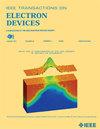BEOL TDDB的三维建模:sub - 20nm半间距互连的可变性规格
IF 2.9
2区 工程技术
Q2 ENGINEERING, ELECTRICAL & ELECTRONIC
引用次数: 0
摘要
提出了一种实用的后端线(BEOL)时间相关介质击穿(TDDB)两步模型,该模型考虑了BEOL互连中复杂的三维特征。首先,对介电介质中各点提取金属-金属最短直渗透路径(SSPP),并计算其失效概率;最后,利用最弱链路统计量来预测所研究的互连方案的可靠性。该模型拟合了不同厚度的低k平面电容器的TDDB测量,以捕捉模型参数对SSPP长度的依赖关系。该模型用于生成变异性规格,以满足在工作条件下20纳米半间距互连的十年寿命。对于变异性的来源,通过不对准(VM),考虑了尖端到尖端的间距变化,线边缘粗糙度(LER)和模具到模具的间距变化。预测当极紫外光刻(EUV)间隔器辅助多模制版时,标称线间距为7 nm是可靠的。此外,该模型表明,完全自对准通孔(FSAV)工艺可以使标称线间距小至5纳米,因为它们可以防止通孔到线的故障。本文章由计算机程序翻译,如有差异,请以英文原文为准。
Three-Dimensional Modeling of BEOL TDDB: Variability Specs for Sub-20 nm Half-Pitch Interconnects
A pragmatic 2-step model of back-end-of-line (BEOL) time-dependent dielectric breakdown (TDDB) is proposed, which accounts for the complex 3-D features in BEOL interconnects. First, for each point in the dielectric, the metal-to-metal shortest straight percolation path (SSPP) is extracted and the related failure probability is computed. Finally, weakest-link statistics are applied to predict the reliability of the investigated interconnect scheme. This model is fit to TDDB measurements from low-k planar capacitors with different thickness to capture the dependence of the model parameters on the SSPP length. This model is applied to generate variability specs for meeting ten years lifetime at operating conditions for sub-20 nm half-pitch interconnects. As for variability sources, via misalignment (VM), tip-to-tip spacing variation, line-edge roughness (LER), and die-to-die spacing variation are considered. It is predicted that nominal line-to-line spacings of 7 nm can be reliable when extreme ultraviolet lithography (EUV) spacer-assisted multi patterning is used as a litho-patterning process. Moreover, this model shows that fully self-aligned via (FSAV) processes can enable nominal line-to-line spacings as small as 5 nm, as they can prevent via-to-line failures.
求助全文
通过发布文献求助,成功后即可免费获取论文全文。
去求助
来源期刊

IEEE Transactions on Electron Devices
工程技术-工程:电子与电气
CiteScore
5.80
自引率
16.10%
发文量
937
审稿时长
3.8 months
期刊介绍:
IEEE Transactions on Electron Devices publishes original and significant contributions relating to the theory, modeling, design, performance and reliability of electron and ion integrated circuit devices and interconnects, involving insulators, metals, organic materials, micro-plasmas, semiconductors, quantum-effect structures, vacuum devices, and emerging materials with applications in bioelectronics, biomedical electronics, computation, communications, displays, microelectromechanics, imaging, micro-actuators, nanoelectronics, optoelectronics, photovoltaics, power ICs and micro-sensors. Tutorial and review papers on these subjects are also published and occasional special issues appear to present a collection of papers which treat particular areas in more depth and breadth.
 求助内容:
求助内容: 应助结果提醒方式:
应助结果提醒方式:


